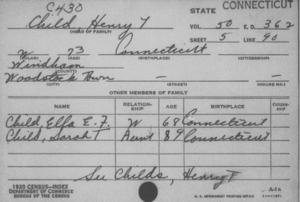Okay, I know the title of this post is not going to be popular amongst many of our readers. My original title contained at least one curse word! It’s not that I do not care about the 1950 census, it’s more of an overall appreciation of how many more records are now available at our fingertips, as well as the rise, and partial fall, of the U.S. census as a go-to resource in genealogy.
When I began doing genealogy in the 1990s, I used the census sparingly. The census was then only available on microfilm and the book indexes were largely organized by head of household, or by individuals with a surname other than the household head. NEHGS had a complete 1910 census for the entire country, but for the (then-recently-released) 1920 census, we only had the New England states, and I would have to go over to the Boston Public Library to use the 1920 census for other states. To find individuals, you would find your surname by the SOUNDEX. When was the last time I had to use that?!
A game changer came as Ancestry.com began to index the censuses by every name. The 1930 census came out when I was in college. Well before any index was completed, I found all four of my teenaged grandparents. They were all living in small towns, so it was not so difficult. Had I waited just a couple of months until the index was completed, this search of a few hours would have only taken me a few minutes! In a way, that’s how the census has spoiled us. Because it is often so quick to search, we might overlook other valuable resources because of how long looking through those records might take us. This is not meant to diminish the importance of the census, only to partially explain why it is used more than other records.
Why was I so interested in finding her?
I was likewise excited when the 1940 census came out, but now comes the part about many more records being available than before. One of the reasons I wanted to see this census was to see if my great-great-grandmother, Mary Rosella “Rosa” (Through) (Helman) Whipple (born in 1858), was still alive! She was the only one of my great-great-grandparents that I had not “killed off.” She was living in 1930 in Hatfield, Pennsylvania, but I could not find her in the 1940 census. Why was I so interested in finding her? At the time Pennsylvania did not have an open index of death certificates. You essentially had to know the year your ancestor died to request a death certificate. I knew that for all my other ancestors who died in the Keystone State, but due to a divorce and some estrangement, no one on that side of the family knew exactly when Rosa died. Pennsylvania later released an online index; I soon found her, dying in Allentown in 1950, and ordered her death certificate. However, had I waited a few more years, I could have found her in the online database of Pennsylvania Death Certificates, 1906-1968.
This all goes to say, Will I be rushing on day one of the 1950 census debut? Probably not. This census will have my father’s parents with his older sister, and my mother’s parents with two of her older siblings.[1] I already know where they were living. I know it’s a valuable resource, and it will be terrific when working with younger people as this might be the first census where their grandparent, or even a great-grandparent, first appears as a child under ten years old, giving us a starting point to extend their ancestry further back.
Note
[1] I have found my mother, born in Kansas in 1952, in eight annual state censuses of Kansas 1953-61.
Share this:
About Christopher C. Child
Chris Child has worked for various departments at NEHGS since 1997 and became a full-time employee in July 2003. He has been a member of NEHGS since the age of eleven. He has written several articles in American Ancestors, The New England Historical and Genealogical Register, and The Mayflower Descendant. He is the co-editor of The Ancestry of Catherine Middleton (NEHGS, 2011), co-author of The Descendants of Judge John Lowell of Newburyport, Massachusetts (Newbury Street Press, 2011) and Ancestors and Descendants of George Rufus and Alice Nelson Pratt (Newbury Street Press, 2013), and author of The Nelson Family of Rowley, Massachusetts (Newbury Street Press, 2014). Chris holds a B.A. in history from Drew University in Madison, New Jersey.View all posts by Christopher C. Child →
